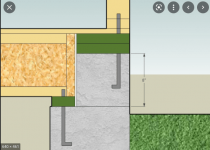What are some waterproof options for pool house flooring? The pool house will have a basement and I priced doing a raised structure floor (concrete slab poured on metal trays and supported by steel beams) and it was very costly. So the floor system will be traditional wood joist. The poured walls will have a shoulder at the top (see photo) that will allow the joist to be lowered from the top of the wall so that after finished, it will be at deck level. The deck will slope away from the pool house and water will be carried away by deck drains. There will be a 3/4" sheet subfloor and I need to decide on a finish flooring to go on top of that. Possible options are,...stone veneer, tile, a waterproof plank flooring, etc. It will get wet so I want to make sure whatever I use will keep the water off the subfloor.
The picture below is similar to what I will do. The foundation on the pool side will be level with the top of the poured wall and sloped away. It will be a 12" thick poured wall and have a 8" shoulder for the joist/sill plate to sit on and leave a 4" collar on the outside all around.
Any recommendations?
The picture below is similar to what I will do. The foundation on the pool side will be level with the top of the poured wall and sloped away. It will be a 12" thick poured wall and have a 8" shoulder for the joist/sill plate to sit on and leave a 4" collar on the outside all around.
Any recommendations?


